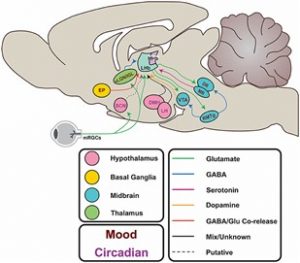
The habenula (LHb and MHb) sits within various neural circuits, each contributing differently to its physiology. For example, it is highly connected to midbrain monoamine centres, which regulate the amount of serotonin and dopamine in the brain. These signalling chemicals are closely linked to psychiatric health, thus positioning the habenula well to govern mood-related behaviour. Moreover, it is closely linked with various circadian centres. This includes the ‘master clock’ (SCN), which drives most rhythmicity across the brain and body.
Circadian rhythms are the physiological changes which occur throughout the day. Known colloquially as the ‘the body clock’, they govern everything from sleep/wake cycles to body temperature, and contribute massively to health. Circadian disruptions are a common symptom of depression, a psychiatric disorder characterised by low mood. Trying to understand the link between depression and circadian rhythms is a difficult challenge, but could lead to insight in the neuropathology of this disorder.
This article explores the habenula as the locus for such an interaction. The habenula is a brain structure which, for some years, has been the focus of much psychiatric research; receiving investigations from a wide breadth of angles including psychosurgery, neuropharmacology and animal behaviour. Moreover, the habenula is part of an ‘extended neural circadian circuit’. This means that the habenula is connected to various ‘circadian centres’ in the brain, and shows its own intrinsic rhythmicity.
Through the lens of circadian and mental health research, this review summarises the habenula’s physiology, anatomy and influence over behaviour. It also poses hypotheses for future experiments, which could further elucidate the interaction between mood and circadian variability in the habenula.
Callum Young, SWBio DTP student
Review: Circadian Influences on the Habenula and Their Potential Contribution to Neuropsychiatric Disorders by Callum J. Young, David Lyons and Hugh D. Piggins in Frontiers in Behavioural Neuroscience.
